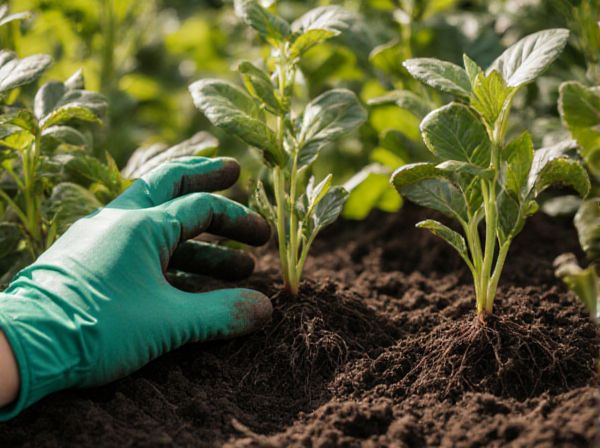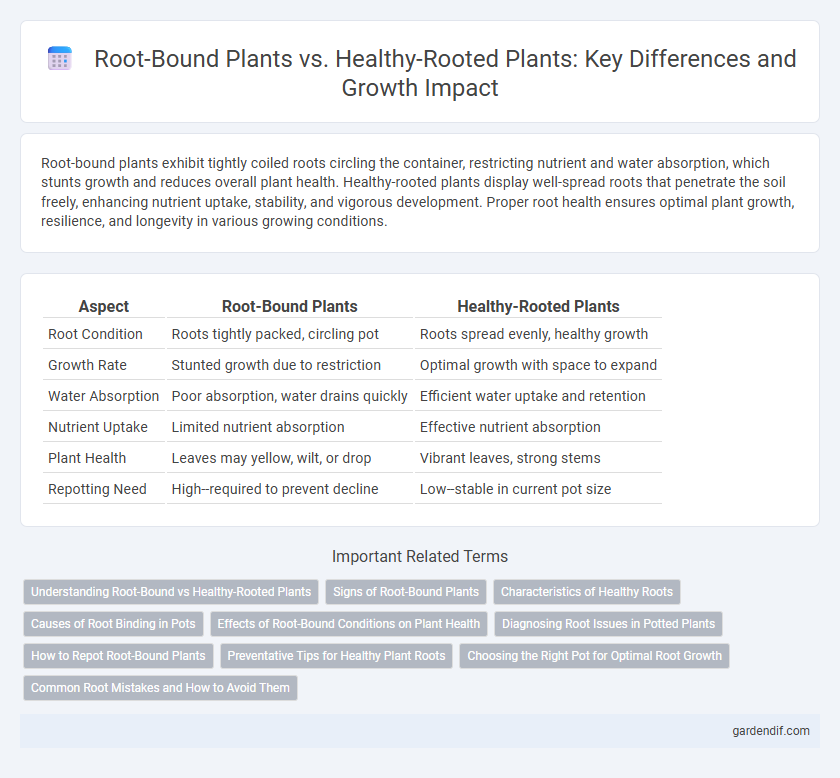
Root-bound plants vs Healthy-rooted plants Illustration
Root-bound plants exhibit tightly coiled roots circling the container, restricting nutrient and water absorption, which stunts growth and reduces overall plant health. Healthy-rooted plants display well-spread roots that penetrate the soil freely, enhancing nutrient uptake, stability, and vigorous development. Proper root health ensures optimal plant growth, resilience, and longevity in various growing conditions.
Table of Comparison
| Aspect | Root-Bound Plants | Healthy-Rooted Plants |
|---|---|---|
| Root Condition | Roots tightly packed, circling pot | Roots spread evenly, healthy growth |
| Growth Rate | Stunted growth due to restriction | Optimal growth with space to expand |
| Water Absorption | Poor absorption, water drains quickly | Efficient water uptake and retention |
| Nutrient Uptake | Limited nutrient absorption | Effective nutrient absorption |
| Plant Health | Leaves may yellow, wilt, or drop | Vibrant leaves, strong stems |
| Repotting Need | High--required to prevent decline | Low--stable in current pot size |
Understanding Root-Bound vs Healthy-Rooted Plants
Root-bound plants exhibit tightly packed, circling roots often resulting in nutrient deficiencies and stunted growth due to restricted root expansion within the pot. Healthy-rooted plants display well-distributed, white roots that extend freely, promoting efficient water absorption, nutrient uptake, and overall plant vigor. Monitoring root health through regular inspection and repotting ensures optimal root development and prevents common issues associated with root-bound conditions.
Signs of Root-Bound Plants
Root-bound plants exhibit tightly circled roots at the pot's edge, stunted growth, and yellowing or wilting leaves due to restricted nutrient uptake. Their root mass often appears dense and matted, causing poor water absorption and drainage issues. Identifying these signs early helps prevent plant stress and promotes healthier root development.
Characteristics of Healthy Roots
Healthy-rooted plants display white or light tan roots that are firm and evenly spaced throughout the soil, ensuring efficient water and nutrient absorption. Healthy roots exhibit abundant fine root hairs, which increase surface area and facilitate optimal uptake of essential minerals. Unlike root-bound plants, these roots grow outward and downward, providing stability and promoting vigorous plant growth.
Causes of Root Binding in Pots
Root binding in pots occurs primarily due to restricted space, causing roots to circle around the container instead of expanding outward. Limited soil volume combined with infrequent repotting prevents proper root growth and nutrient uptake, leading to root-bound plants. Overcrowded roots deplete soil resources rapidly, resulting in stunted growth compared to healthy-rooted plants with adequate room for root proliferation.
Effects of Root-Bound Conditions on Plant Health
Root-bound plants experience restricted root growth that limits nutrient and water absorption, leading to stunted growth and yellowing leaves. The compacted root mass reduces oxygen availability, increasing susceptibility to root rot and diseases. In contrast, healthy-rooted plants exhibit optimal root expansion, promoting efficient nutrient uptake and overall vigorous development.
Diagnosing Root Issues in Potted Plants
Diagnosing root issues in potted plants involves examining root-bound plants, which exhibit tightly coiled, overcrowded roots that restrict nutrient absorption and water uptake. Healthy-rooted plants display well-spread, white or light-colored roots with sufficient space for growth, indicating proper aeration and soil health. Identifying root-bound conditions early prevents stunted growth and supports timely repotting to restore optimal root function.
How to Repot Root-Bound Plants
Repotting root-bound plants requires gently loosening the densely packed roots to encourage new growth and prevent stress. Choose a pot slightly larger than the current one with fresh, well-draining soil to provide adequate space and nutrients. Water thoroughly after repotting and place the plant in indirect light to support recovery and healthy root development.
Preventative Tips for Healthy Plant Roots
Root-bound plants suffer from restricted growth caused by overcrowded roots within pots, leading to nutrient deficiencies and stunted development. Healthy-rooted plants exhibit well-spread, white roots that maximize water and nutrient absorption, promoting vigorous growth. Preventative tips include choosing appropriately sized containers, regularly loosening root balls during repotting, and ensuring proper soil aeration to maintain optimal root health.
Choosing the Right Pot for Optimal Root Growth
Selecting the right pot size is crucial for optimal root growth, as root-bound plants exhibit tightly packed, circling roots that restrict nutrient absorption and stunt growth. Healthy-rooted plants thrive in pots with adequate space, promoting proper root expansion, aeration, and water drainage. Choosing containers with appropriate volume and drainage holes supports balanced root development and overall plant health, preventing common issues associated with root-bound conditions.
Common Root Mistakes and How to Avoid Them
Root-bound plants often suffer from overcrowded roots that circle and constrict growth, inhibiting nutrient and water absorption while stressing the plant. Common mistakes include neglecting regular repotting and choosing containers too small, which trap roots and stifle development. To avoid these issues, use appropriately sized pots, regularly check root health, and gently loosen root balls during repotting to encourage robust, healthy root systems.
Root-bound plants vs Healthy-rooted plants Infographic

 gardendif.com
gardendif.com